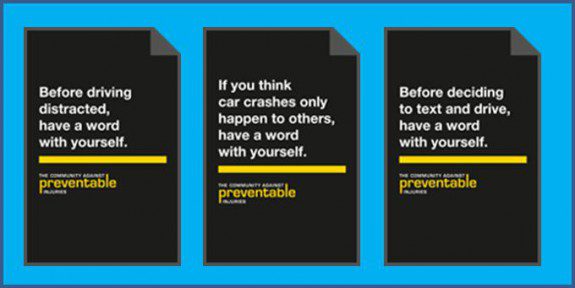On the average commute home from work, it’s easy to observe people regularly carry out any number of “at-risk” behaviors on the roads: not following traffic signals, texting while driving, or driving at excessive speeds.
When it comes to driving, it seems Canadians have a very high risk tolerance. This is certainly understandable in a province like Alberta, that was built on taking a measure of risk (the “pioneering” and “get it done” behaviors we admire in successful people and companies). And by no means do I mean to dampen this spirit and energy, but the reality is that risky behaviors like these are taking a terrible toll. Every day in Alberta, four people die, 20 people are permanently disabled, 80 people are hospitalized, 1200 people visit emergency rooms, all from avoidable incidents that include motor vehicle collisions.
The reality of just how preventable these incidents are sets in when when listening to the survivors of collisions. Statements like: “if only we would’ve slowed up a bit on our trip, John would be alive today to see his children grown, and I wouldn’t be at my daughter’s wedding going down the aisle with her in a wheelchair.” The cost of a collision like this is one fatality, one permanent disability, and a lifetime of regret for those impacted. The investment to have prevented it would have been five or 10 minutes more of travel time on a one hour trip. The key, I believe, to preventing collisions like these is to reduce our risk tolerance.
But the reality is that reducing risk tolerance is rarely a priority when we carry out routine and repetitive activities. This results in warped perceptions of risk. Too often, we believe that taking risks works. We do it all the time and nothing ever happens. There is a sense of invincibility, accidents happen to other people, not us. And while there are many instances within our life experience where we can carry out higher risk activities without realizing an adverse consequence, when we persist in this complacency, for some it is not a matter of “if” but “when” they fall within the statistical grouping of people that die in collision (391 in Alberta in 2008, and the leading cause of death for Albertans in the age group 15 to 19).
Many of us also believe that driving is a routine activity that leaves us open to do other things that seem more important at the time. But again, reduced alertness and inattention means we treat driving as a nonhazardous activity when nothing could be further from the truth. Consider that you have some 1.5 metric tons of material hurtling at between 14 to 28 meters per second (50 to 100 km/h) that in a collision can come to a stop with crushing deceleration, trapping occupants in a tangle of rapidly deforming metal and exposed to severe impact. And pedestrians struck by a vehicle simply have no protection at all from such large sources of unchecked energy. You are about five times more at-risk when using your phone in the car, even when it’s hands-free, of being in a collision. When texting while driving you have over 20 times more risk of a crash or near-crash event.
Reducing risk tolerance starts with reconnecting people with their perceptions, confronting them with the reality of these long-held positions, and encouraging alternate behaviors to limit risk exposures. How can this be accomplished? The most promising avenue may be best described as “marketing” the value of reducing risk tolerance. Building on the data from a similar initiative in British Columbia, and surveying target populations in Alberta to quantify marketing effectiveness, Preventable.ca projected conservatively that in Alberta alone, this initiative could result in 50 fewer deaths, 1800 fewer hospitalizations, 45,000 fewer emergency department visits over a period of five years for those 54 and younger.
While marketing to change risk tolerance will never be enough on its own to prevent all collisions, it can work in harmony with road and automobile design, as well as regulation and enforcement, to form a comprehensive prevention strategy.
Is there a place in your life where you are taking on a dangerous level of risk without thinking about it? Have a word with yourself the next time you drive. It could save your life.



The comments section is closed.
A good place to start (to reduce road “accidents”) would be to look to the German model of driver instruction and testing. It is VERY extensive and rigorous – but pays off. Despite some VERY high-speed driving there, they have far fewer accidents (relative to population, distances travelled, etc.) (Don’t, however, hold your breath for the early adoption of this suggestion!)
Research elsewhere has also shown that “hands free” telephoning whilst driving is as distracting as using hand-held devices. Solution – ban the installation of ANY such means of communication in vehicles. (This, I’m sure, would not be popular and could be circumvented with cell or smart phones but, together with “education” might help drivers appreciate that driving alone requires ALL your attention – again, not an idea that is likely to catch on any time soon!)